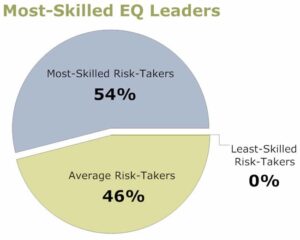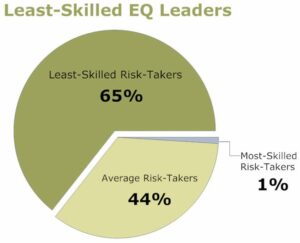By Dr. Travis Bradberry & Lac D. Su, M.S.
While the economy continues to hold its head above water due to dumb risks some of the world’s most powerful companies have taken, TalentSmartEQ® researchers decided to take a close look at what separates the good risk-takers from the bad. Why do some leaders take careless risks that defy logic and threaten the survival of their whole enterprise? Why are other leaders so successful at taking the risks required to ensure their organizations’ future prosperity?
In a previous issue of the TalentSmartEQ® Newsletter, we uncovered the critical link between decision making and emotional intelligence (EQ). In this issue, we’re revisiting the same sample of 716 leaders, from a cross-section of industries, and comparing their risk-taking skill to their level of emotional intelligence (with data collected using the 360o Refined™ assessment). Our first “Ah-ha!” came with the discovery that 65% of leaders with little to no skill at recognizing and managing their emotions were also those who were least likely to walk away from unnecessary risks. In the same vein, 54% of the emotionally intelligent leaders were among the most skilled risk-takers. It seems that leaders who “pay attention to how others influence their emotional states” are also the ones who reject unnecessary risk, yet know when is the right time to accelerate beyond commonly accepted boundaries. We find these leaders are able to take responsibility for grim situations, and are willing to risk their status and comfort in order to stand behind bold, new ideas that will keep their companies flourishing.


Since most of us don’t work in complete isolation, our emotions and the risks they cause us to take are significantly linked to other people. In a study at the Israel Institute of Technology, psychologist Eldad Yechiam paired people up and gave them a series of choices between risky and safe options. Yechiam found that those who watched other people reap rewards for taking risks were significantly more likely to take risks themselves. In contrast, those who made their choices in isolation selected safer options. Logically, of course, all participants had the same choices. But emotionally, it just feels safer when we watch someone else take a risk first. In fact, we fear it is an even bigger risk not following suit when our co-workers and competitors seem to be getting rewarded for taking risks. This is a lesson that typically risk-averse bank executives learned the hard way when they made the ill-fated choice to follow their competitors into the risky game of sub-prime lending.
Yechiam’s team told another group of participants that their choices were being watched by peers but that they themselves could not watch others. This group actually seemed risk-averse. It appears that the anxiety about being under the spotlight caused them to avoid taking risk altogether—even those risks that offered high rewards.
When leaders make decisions without acknowledging their fear or excitement, they are lulled into a sense of false security. They use all sorts of logical arguments to rationalize why they should or should not take a risk, oblivious to the hidden emotions driving their “logical analysis.”
Putting Research into Action
It is not the mere presence of fear and anxiety or excitement and greed that cause a person to take poor risks. High EQ leaders have not figured out a way to delete these feelings. Instead, they have simply learned to recognize and manage those emotions. Here are a few tips for getting a handle on your emotions and using them effectively when taking risks.
- Understand Your Emotions as They Happen. Observe what you are feeling and doing as the situation unfolds, rather than waiting until things go so far that your emotions make it hard for you to see the risks and rewards objectively. Don’t wait until your emotions go away either. It is critical to learn about these feelings in the moment so you can harness them.
- Step Away from the Emotional Situation. Keep your finger on the pulse of your emotions and know when to allow yourself the opportunity to step back from the situation. This prevents you from jumping headlong into careless risks or letting an initial twinge of fear cause you to reject a great opportunity. Give your brain time to process your emotions and re-center itself on logic. Try picturing the current situation in your head as if it were happening to someone else. What would you recommend that person do in order to create the best results?
- Prepare Yourself for Change. Change always feels risky at first so expect anxiety, but don’t let it scare you away. Anticipate it and prepare yourself for it. Talk through your thoughts and feelings with a third party who may not be as closely involved with the situation. Then, if change happens, accept the fact that you may not have complete control over the events, but you can control your reaction to the circumstances. With a full awareness of your emotional reactions to the situation, you can take comfort knowing that any risks you take are more thoughtful and calculated.
ABOUT THE AUTHOR:
Travis Bradberry, Ph.D.
Dr. Travis Bradberry is the award-winning co-author of the #1 bestselling book, Emotional Intelligence 2.0, and the cofounder of TalentSmartEQ, the world’s leading provider of emotional intelligence tests and training, serving more than 75% of Fortune 500 companies. His bestselling books have been translated into 25 languages and are available in more than 150 countries. Dr. Bradberry has written for, or been covered by, Newsweek, BusinessWeek, Fortune, Forbes, Fast Company, Inc., USA Today, The Wall Street Journal, The Washington Post, and The Harvard Business Review.
Lac D. Su, M.S.
Lac D. Su is the Director of Strategic Alliances for TalentSmartEQ, the leading provider of emotional intelligence tests, products, and training. He forms and manages relationships with key TalentSmartEQ resellers and assists clients with the implementation of skill development initiatives.